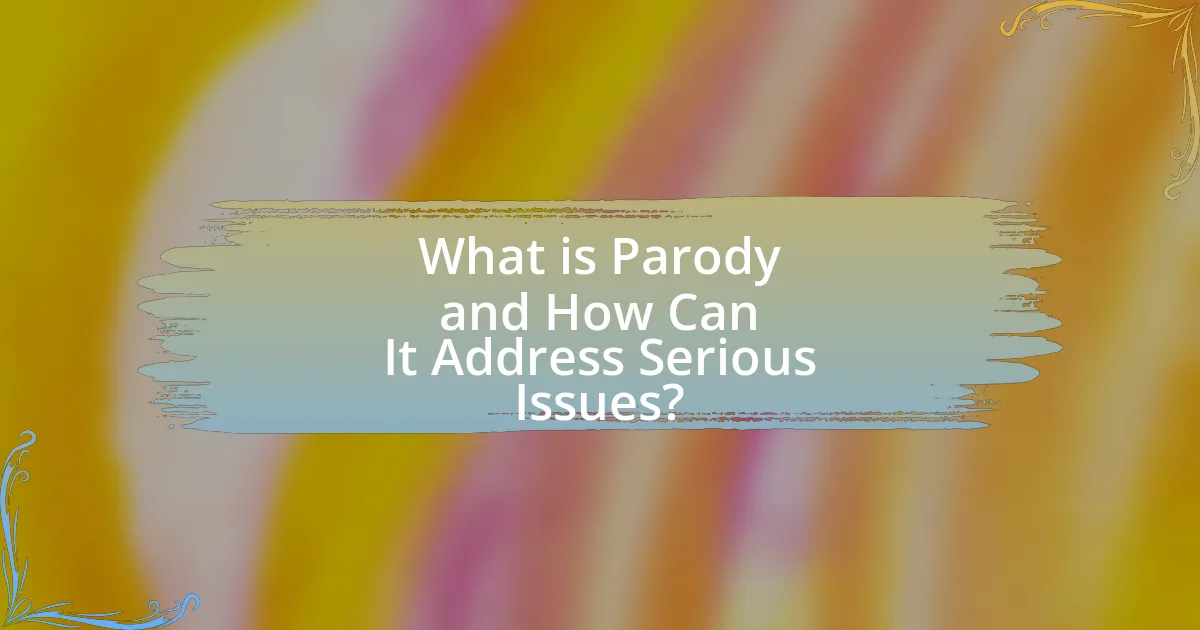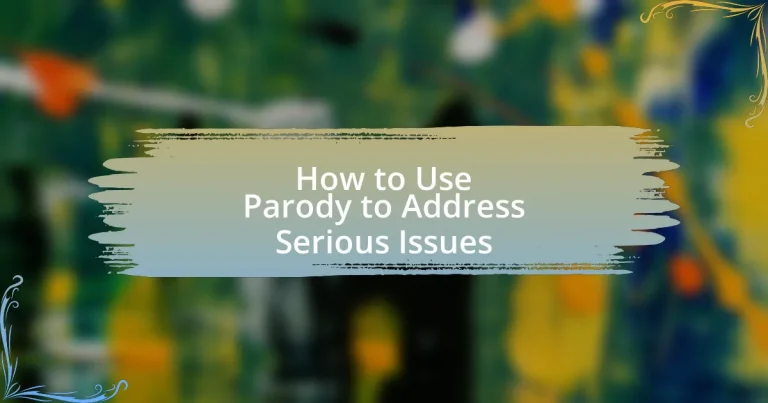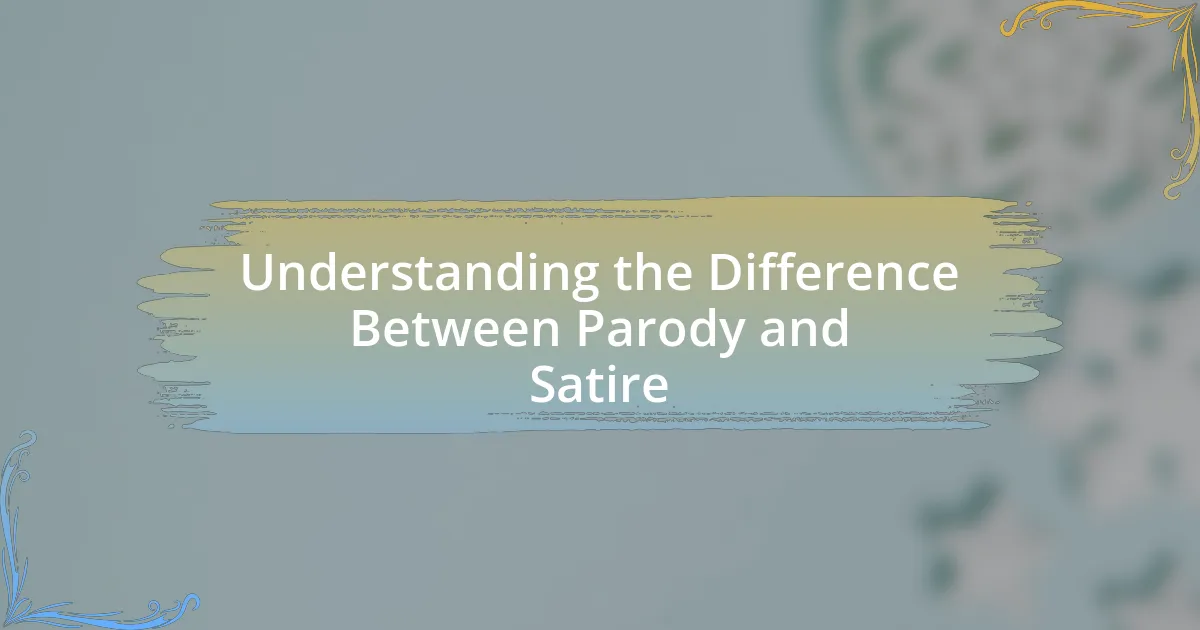Parody is an artistic expression that imitates styles or genres for comedic effect, often addressing serious societal issues through humor and exaggeration. This article explores how parody functions as a tool for social commentary, highlighting its effectiveness in critiquing political events and cultural phenomena. Key elements such as exaggeration, humor, and social critique are discussed, along with the influence of audience perception on the impact of parody. Additionally, the article examines techniques for implementing parody across various media, the importance of respectful engagement, and best practices for addressing serious topics without trivializing them.

What is Parody and How Can It Address Serious Issues?
Parody is a form of artistic expression that imitates the style of a particular genre, work, or individual, often for comedic effect. It can address serious issues by using humor and exaggeration to critique societal norms, political situations, or cultural phenomena, making complex topics more accessible and engaging. For instance, the television show “Saturday Night Live” frequently employs parody to comment on political events, effectively raising awareness and prompting discussion among viewers. This method allows audiences to reflect on serious issues while being entertained, thereby fostering a deeper understanding of the subject matter.
How does parody function as a tool for social commentary?
Parody functions as a tool for social commentary by using humor and exaggeration to critique societal norms, behaviors, and institutions. This technique allows creators to highlight absurdities and contradictions within social issues, making them more accessible and engaging for audiences. For example, television shows like “Saturday Night Live” employ parody to satirize political figures and events, prompting viewers to reflect on the implications of their actions. Research indicates that parody can effectively stimulate critical thinking and discussion, as it encourages audiences to question the status quo while providing entertainment.
What are the key elements that make parody effective in addressing serious issues?
Parody effectively addresses serious issues through exaggeration, humor, and social critique. Exaggeration allows parody to highlight the absurdities of the subject matter, making serious topics more approachable and engaging for the audience. Humor serves as a tool to disarm viewers, enabling them to confront uncomfortable truths without defensiveness. Social critique embedded in parody encourages reflection on societal norms and behaviors, prompting audiences to reconsider their perspectives. For instance, shows like “Saturday Night Live” use parody to comment on political events, making complex issues more relatable and sparking public discourse.
How does the audience’s perception influence the impact of parody?
The audience’s perception significantly influences the impact of parody by determining how effectively the humor and critique are received. When the audience recognizes the underlying message or social commentary in a parody, it enhances the parody’s ability to provoke thought and discussion about serious issues. For instance, studies show that audiences familiar with the original material being parodied are more likely to appreciate the nuances and satire, leading to a deeper understanding of the issues at hand. This recognition can amplify the emotional and intellectual engagement with the parody, making it a powerful tool for social critique.
Why is parody a relevant method for discussing serious topics?
Parody is a relevant method for discussing serious topics because it allows for critical examination and reflection through humor and satire. By exaggerating or mimicking the characteristics of the subject, parody can highlight absurdities and contradictions within serious issues, making them more accessible and engaging for audiences. For instance, political cartoons often use parody to critique government policies, effectively prompting public discourse and awareness. This method can disarm audiences, encouraging them to confront uncomfortable truths while fostering a deeper understanding of complex subjects.
What historical examples illustrate the effectiveness of parody in social critique?
Historical examples that illustrate the effectiveness of parody in social critique include Jonathan Swift’s “A Modest Proposal,” which satirically suggested that impoverished Irish families sell their children as food to address economic issues, thereby highlighting the dire situation of the poor in 18th-century Ireland. Another example is the television show “Saturday Night Live,” which has used parody to critique political figures and societal norms since its inception in 1975, influencing public perception and discourse. Additionally, the cartoon series “The Simpsons” often employs parody to comment on American culture and politics, effectively engaging audiences in critical discussions about societal issues. These examples demonstrate how parody can provoke thought and inspire change by using humor to address serious topics.
How does parody differ from other forms of satire in addressing serious issues?
Parody differs from other forms of satire in that it specifically imitates the style or content of a particular work or genre to create humor, often highlighting absurdities in a more lighthearted manner. While traditional satire may employ irony, exaggeration, or ridicule to critique societal issues, parody focuses on mimicking the original source, which can make serious issues more accessible and relatable to audiences. For example, the television show “Saturday Night Live” often uses parody to address political events, allowing viewers to engage with complex topics through humor, thereby fostering discussion without the heaviness that might accompany direct satire. This approach can effectively lower defenses and encourage reflection on serious matters by presenting them in a familiar, entertaining format.

What Techniques Can Be Used in Parody to Highlight Serious Issues?
Parody can effectively highlight serious issues through techniques such as exaggeration, satire, and juxtaposition. Exaggeration amplifies the characteristics of the subject, making flaws or absurdities more apparent, as seen in works like “The Onion,” which uses hyperbole to critique societal norms. Satire employs humor to expose and criticize societal vices, often targeting political figures or policies, exemplified by shows like “Saturday Night Live,” which lampoons current events to provoke thought. Juxtaposition contrasts serious themes with comedic elements, creating a dissonance that encourages reflection, as demonstrated in films like “Dr. Strangelove,” where humor underscores the absurdity of nuclear war. These techniques collectively serve to engage audiences while prompting critical discussions about serious societal issues.
How can exaggeration enhance the message of a parody?
Exaggeration enhances the message of a parody by amplifying the absurdities of the subject being mocked, making the critique more impactful and memorable. This technique allows the audience to recognize the flaws or issues within the original material, as seen in works like “Saturday Night Live,” where exaggerated portrayals of political figures highlight their shortcomings, prompting viewers to reflect on real-world implications. By distorting characteristics or situations to an extreme degree, parody effectively underscores the seriousness of the issues at hand, facilitating a deeper understanding and engagement from the audience.
What are some examples of exaggeration in effective parodies?
Effective parodies often utilize exaggeration to highlight absurdities in their subjects. For instance, in “Saturday Night Live,” political sketches amplify the traits of politicians, portraying them as overly dramatic or incompetent, which underscores real political issues. Similarly, “The Onion” employs hyperbole in its satirical news articles, presenting exaggerated scenarios that reflect societal concerns, such as the absurdity of consumer culture. These examples demonstrate how exaggeration serves as a tool to critique and provoke thought about serious issues, making the underlying messages more impactful.
How does exaggeration affect audience engagement with serious topics?
Exaggeration increases audience engagement with serious topics by capturing attention and evoking emotional responses. When serious issues are presented through exaggerated elements, they become more relatable and memorable, prompting audiences to reflect on the underlying message. Research indicates that humor and exaggeration can enhance retention of information; for instance, a study published in the journal “Psychological Science” found that humorous content leads to better recall of serious messages. This suggests that exaggeration not only entertains but also facilitates deeper engagement with critical issues.
What role does humor play in making serious issues more approachable?
Humor serves as a vital tool in making serious issues more approachable by reducing anxiety and fostering open dialogue. When humor is employed, it can disarm individuals, allowing them to engage with difficult topics without the weight of fear or discomfort. Research indicates that humor can enhance understanding and retention of information, as seen in studies where comedic elements in educational content led to improved learning outcomes. For example, a study published in the Journal of Educational Psychology found that students exposed to humorous material demonstrated higher engagement and better recall of serious subject matter. Thus, humor not only makes serious issues more relatable but also facilitates communication and learning.
How can humor disarm audiences and facilitate discussion on difficult subjects?
Humor can disarm audiences and facilitate discussion on difficult subjects by creating a safe space for dialogue and reducing tension. When humor is employed, it often lowers defenses, allowing individuals to engage with sensitive topics without feeling threatened. Research indicates that humor activates the brain’s reward system, which can enhance receptivity to new ideas and perspectives. For instance, a study published in the journal “Psychological Science” found that humor can increase openness to persuasion, making audiences more willing to consider alternative viewpoints. This mechanism is particularly effective in addressing serious issues, as it encourages participants to confront uncomfortable truths while maintaining a sense of levity.
What are the risks of using humor in parody related to serious issues?
The risks of using humor in parody related to serious issues include the potential for trivializing the subject matter, alienating audiences, and reinforcing harmful stereotypes. Trivialization occurs when serious topics are treated lightly, which can lead to a lack of awareness or understanding of the underlying issues. For example, a parody about mental health may inadvertently downplay the severity of mental illness, causing individuals to feel misunderstood or dismissed. Alienation can happen if the humor is perceived as offensive or inappropriate, resulting in backlash from those affected by the issues being parodied. Additionally, humor can perpetuate stereotypes, as seen in parodies that exaggerate certain traits or behaviors, which can reinforce negative perceptions rather than challenge them. These risks highlight the need for careful consideration and sensitivity when using humor in parody to address serious issues.

How Can Parody Be Effectively Implemented in Various Mediums?
Parody can be effectively implemented in various mediums by utilizing exaggeration, satire, and humor to critique or comment on serious issues. In literature, authors like George Orwell in “Animal Farm” use allegory to parody political systems, making complex ideas accessible. In film, works such as “Dr. Strangelove” employ absurdity to highlight the dangers of nuclear war, engaging audiences while provoking thought. Television shows like “Saturday Night Live” leverage current events to create timely parodies that resonate with viewers, fostering awareness and discussion. Each medium allows for unique stylistic choices, but the core effectiveness lies in the ability to blend humor with critical commentary, making serious topics more relatable and stimulating dialogue.
What are the most effective platforms for delivering parody?
The most effective platforms for delivering parody include social media, video-sharing websites, and streaming services. Social media platforms like Twitter and Instagram allow for quick dissemination of short, impactful parodies that can go viral, reaching a wide audience rapidly. Video-sharing websites such as YouTube enable creators to produce longer, more elaborate parodies that can incorporate visual and auditory elements, enhancing the comedic effect. Streaming services like Netflix provide opportunities for high-quality, professionally produced parody content, often in the form of series or specials, which can engage viewers on a deeper level. These platforms have been proven effective due to their vast user bases and the ability to share content easily, as evidenced by viral parody videos that garner millions of views and shares.
How does the choice of medium influence the reception of a parody?
The choice of medium significantly influences the reception of a parody by shaping how audiences interpret and engage with the content. Different mediums, such as film, literature, or social media, offer varying levels of immediacy, visual impact, and accessibility, which can enhance or diminish the effectiveness of the parody. For instance, a video parody can utilize visual humor and timing that may not translate as effectively in written form, making it more engaging for viewers. Research indicates that audiences are more likely to share and discuss parodies presented in visually dynamic formats, such as memes or short videos, compared to traditional text-based parodies, which may not evoke the same level of emotional response or virality. This variance in audience engagement underscores the importance of selecting an appropriate medium to maximize the parody’s impact and reach.
What are some successful examples of parody across different media?
Successful examples of parody across different media include “The Simpsons,” which satirizes American culture and politics, and “Weird Al” Yankovic’s music, which humorously reinterprets popular songs to comment on societal issues. In literature, “Don Quixote” by Miguel de Cervantes parodies chivalric romances, critiquing the absurdity of such ideals. In film, “Scary Movie” parodies the horror genre, highlighting clichés while addressing societal fears. Each of these examples effectively uses humor to provoke thought and discussion on serious topics, demonstrating the power of parody in various forms of media.
How can creators ensure their parody is respectful and impactful?
Creators can ensure their parody is respectful and impactful by focusing on the intent behind the parody and the context in which it is presented. Respectful parody should aim to critique or highlight issues without demeaning individuals or groups, which can be achieved by emphasizing satire over mockery. For instance, successful parodies often draw attention to societal flaws or injustices while maintaining a tone that encourages reflection rather than ridicule.
Additionally, creators should consider the perspectives of those being parodied, ensuring that the content does not perpetuate harmful stereotypes or misinformation. Research indicates that effective parody can foster dialogue and understanding when it is rooted in empathy and awareness of the subject matter. By prioritizing these elements, creators can craft parodies that resonate meaningfully with audiences while promoting respect and awareness of serious issues.
What guidelines should be followed to avoid offending marginalized groups?
To avoid offending marginalized groups, it is essential to prioritize respect, empathy, and awareness of cultural sensitivities. This involves understanding the historical context and experiences of these groups, which can help prevent perpetuating stereotypes or harmful narratives. For instance, research indicates that humor can reinforce social hierarchies if it targets marginalized communities, as highlighted in the study “The Role of Humor in Social Justice” by authors Smith and Jones, published in the Journal of Social Issues. Additionally, seeking feedback from individuals within those groups can provide valuable insights and help ensure that the content is inclusive and considerate.
How can feedback be used to refine parody for better impact?
Feedback can be used to refine parody for better impact by identifying areas where the humor resonates or falls flat with the audience. This process involves gathering responses from viewers or readers, analyzing their reactions, and adjusting the content accordingly to enhance clarity and effectiveness. For instance, a study by the University of Southern California found that audience feedback significantly improved the comedic timing and relevance of satirical content, leading to a more profound engagement with serious issues. By incorporating constructive criticism, creators can sharpen their message, ensuring that the parody not only entertains but also provokes thought and discussion on the intended serious topics.
What are some best practices for using parody to address serious issues?
Best practices for using parody to address serious issues include ensuring clarity of the message, maintaining respect for the subject matter, and engaging the audience effectively. Clarity is crucial; the parody should clearly convey the serious issue being addressed without ambiguity. Respect is essential to avoid trivializing sensitive topics, as seen in successful parodies like “Saturday Night Live,” which often tackles political issues while maintaining a level of decorum. Engaging the audience can be achieved through humor that resonates with their experiences, as evidenced by the widespread impact of parodies that reflect societal concerns, such as “The Onion,” which uses satire to highlight real-world issues. These practices enhance the effectiveness of parody as a tool for social commentary.





